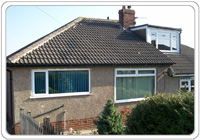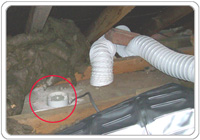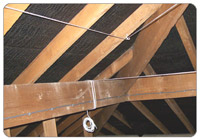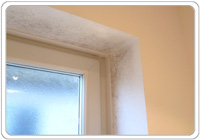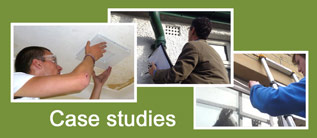
Case study: A semi-detached bungalow near Bradford
with air quality and mould problems
The problem
This bungalow was occupied by two tenants and had a persistent mould problem in the bedrooms and hallway. The occupants frequently cleaned the mould from the walls but it returned in a matter of days.
Both of the occupants were in full time employment and the property was empty and unheated during the day. Condensation forms more easily on cold surfaces and so humidity generated during the morning needs to be efficiently extracted to avoid condensation.
As part of our survey we found that the shower extractor fan was simply venting humid air directly into the loft.
We found that the loft itself was very air-tight. This was because of the old style non-breathable bitumen roofing underlay and lack of ventilation. This meant that the humid air from the shower stayed in the loft or made its way back into the rooms below.
The loft itself had very little insulation, and there was no insulation in the cavity walls.
The windows and doors were modern and draught-proof but by choking of any 'accidental' ventilation they were further adding to the problem.
In summary the property was poorly insulated and very poorly ventilated.
Our solution
Where a house has very little or no ventilation in the loft it is very often the case that this can lead to excess humidity in the rest of the property.
Working on the principle that a loft should be draughty and well ventilated we installed roof vents to bring in fresh air and installed loft insulation (under a grant) to bring it up to the current standard.
We disconnected the existing fan in the bathroom and installed a through-the-wall unit activated by humidity and with an always-on trickle function. This unit was much more efficient and it is activated by humidity it does not rely on the occupants switching a light on to activate it.
In the loft we installed a positive input ventilation unit. Since the property was a small bungalow the unit was set to one of the lowest rates for air infusion. Barely noticeable in operation these systems can have a dramatic effect on air quality and humidity levels.
Lastly we arranged for the cavity walls to be insulated under a grant. The overall result was a property with vastly improved insulation, energy efficient background ventilation, and the very humid air from the bathroom effectively extracted. A warmer fresher, healthier (and mould free) home.
See our page on solutions for condensation problems for further information.
High humidity + inadequate ventilation
= damp, condensation, mould

UK government advises:

